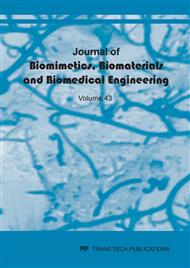[1]
H. Chai, J. J.-W. Lee, P. J. Constantino, P. W. Lucas, and B. R. Lawn, Remarkable resilience of teeth,, Proc. Natl. Acad. Sci., vol. 106, no. 18, p.7289–7293, (2009).
DOI: 10.1073/pnas.0902466106
Google Scholar
[2]
Pulp (tooth) - Wikipedia,, Wikipedia. [Online]. Available: https://en.wikipedia.org/wiki/Pulp_(tooth). [Accessed: 05-Dec-2017].
Google Scholar
[3]
Y.-R. Zhang, W. Du, X.-D. Zhou, and H.-Y. Yu, Review of research on the mechanical properties of the human tooth,, Int. J. Oral Sci., vol. 6, no. 2, p.61–69, (2014).
Google Scholar
[4]
R. K. Nalla, V. Imbeni, J. H. Kinney, S. J. Marshall, and R. O. Ritchie, On the development of life prediction methodologies for the failure of human teeth,, Lawrence Berkeley Natl. Lab., (2002).
DOI: 10.1002/9781118788035.ch13
Google Scholar
[5]
L. L. Howell, Compliant mechanisms. Wiley, (2001).
Google Scholar
[6]
T. T. Akano and O. A. Fakinlede, Fatigue Failure Model for Polymeric Compliant Systems,, ISRN Polym. Sci., vol. 2013, (2013).
DOI: 10.1155/2013/321489
Google Scholar
[7]
J. C. S. J. W. Ju and J. C. Simo, Strain and Stress Based Continuum Damage Models,, Int. J. Solids Struct., vol. 23, no. 7, p.821–869, (1987).
DOI: 10.1016/0020-7683(87)90083-7
Google Scholar
[8]
J. Lemaitre, Formulation and identification of damage kinetic constitutive equations,, in Continuum Damage Mechanics Theory and Application, Springer, 1987, p.37–89.
DOI: 10.1007/978-3-7091-2806-0_2
Google Scholar
[9]
J. D. Gyllenskog, Fatigue life analysis of T-38 aileron lever using a continuum damage approach. Utah State University, (2010).
Google Scholar
[10]
D. Kondo, H. Welemane, and F. Cormery, Basic concepts and models in continuum damage mechanics,, Rev. Eur. génie Civ., vol. 11, no. 7–8, p.927–943, (2007).
DOI: 10.1080/17747120.2007.9692970
Google Scholar
[11]
Y. Xiao, A multi-mechanism damage coupling model,, Int. J. Fatigue, vol. 26, no. 11, p.1241–1250, (2004).
Google Scholar
[12]
H. Li, J. Li, Z. Zou, and A. S.-L. Fok, Fracture simulation of restored teeth using a continuum damage mechanics failure model,, Dent. Mater., vol. 27, no. 7, pp. e125–e133, (2011).
DOI: 10.1016/j.dental.2011.03.006
Google Scholar
[13]
K. Tonami and H. Takahashi, Effects of aging on tensile fatigue strength of bovine dentin,, Dent. Mater. J., vol. 16, no. 2, p.156–169, (1997).
DOI: 10.4012/dmj.16.156
Google Scholar
[14]
J. H. Kinney, R. K. Nalla, J. A. Pople, T. M. Breunig, and R. O. Ritchie, Age-related transparent root dentin: mineral concentration, crystallite size, and mechanical properties,, Biomaterials, vol. 26, no. 16, p.3363–3376, (2005).
DOI: 10.1016/j.biomaterials.2004.09.004
Google Scholar
[15]
D. D. Arola and R. K. Reprogel, Tubule orientation and the fatigue strength of human dentin,, Biomaterials, vol. 27, no. 9, p.2131–2140, (2006).
DOI: 10.1016/j.biomaterials.2005.10.005
Google Scholar
[16]
S. Orrego, M. A. Melo, S. Lee, H. H. K. Xu, and D. D. Arola, Fatigue of human dentin by cyclic loading and during oral biofilm challenge,, J. Biomed. Mater. Res. Part B Appl. Biomater., vol. 105, no. 7, p.1978–1985, (2017).
DOI: 10.1002/jbm.b.33729
Google Scholar
[17]
B. Majd, H. Majd, J. A. Porter, E. Romberg, and D. Arola, Degradation in the fatigue strength of dentin by diamond bur preparations: Importance of cutting direction.,, J. Biomed. Mater. Res. B. Appl. Biomater., vol. 104, no. 1, p.39–49, Jan. (2016).
DOI: 10.1002/jbm.b.33348
Google Scholar
[18]
R. K. Nalla, J. H. Kinney, S. J. Marshall, and R. O. Ritchie, On the in vitro fatigue behavior of human dentin: effect of mean stress,, J. Dent. Res., vol. 83, no. 3, p.211–215, (2004).
DOI: 10.1177/154405910408300305
Google Scholar
[19]
R. K. Nalla, V. Imbeni, J. H. Kinney, M. Staninec, S. J. Marshall, and R. O. Ritchie, In vitro fatigue behavior of human dentin with implications for life prediction,, J. Biomed. Mater. Res. Part A, vol. 66, no. 1, p.10–20, (2003).
DOI: 10.1002/jbm.a.10553
Google Scholar
[20]
M. Mahadevaswamy, Finite element analysis and fatigue test on the bicuspids to support theory of abfraction,, (2010).
Google Scholar
[21]
J. Lemaitre, A continuous damage mechanics model for ductile fracture,, J. Eng. Mater. Technol., vol. 107, no. 1, p.83–89, (1985).
Google Scholar
[22]
J.-L. Chaboche, Continuum damage mechanics: Part II—Damage growth, crack initiation, and crack growth,, J. Appl. Mech., vol. 55, no. 1, p.65–72, (1988).
DOI: 10.1115/1.3173662
Google Scholar
[23]
G. B. Stephenson, Evaluation of the Strain Energy Density Method of Notch Stress Concentration Calculations in the Plastic Range.,, Naval Postgraduate School Monterey CA, (1996).
Google Scholar
[24]
Mechanical Properties of Dental Materials | Pocket Dentistry., [Online]. Available: https://pocketdentistry.com/mechanical-properties-of-dental-materials-2/. [Accessed: 01-Apr-2019].
Google Scholar
[25]
ElectroForce Mechanical Test Instruments – TA Instruments., [Online]. Available: https://www.tainstruments.com/products/electroforce-mechanical-testers/. [Accessed: 13-Jul-2019].
Google Scholar


